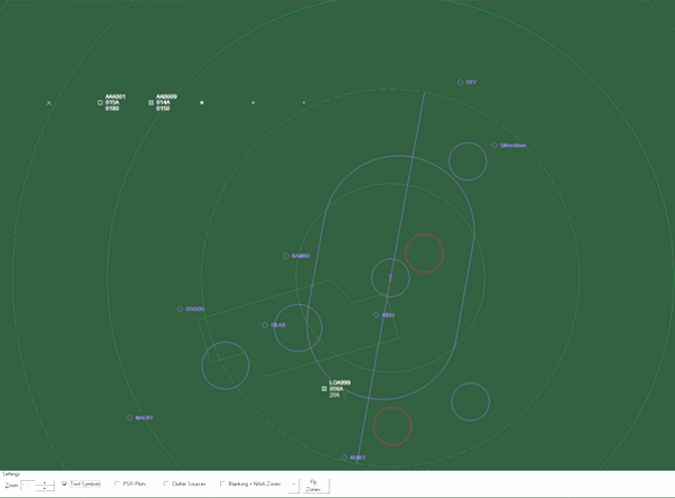Thales standard airport Primary Surveillance Radar (PSR) is the STAR 2000. The radar is quite advanced with a number of existing in-built capabilities for mitigating the effects of wind turbines.
Application
There are over 120 operational Thales Star 2000 radars all over the world. They are located in countries including the United Kingdom (UK), France, Denmark and South Africa.
 Figure 1: A Pager Power simulation of Thales STAR 2000 radar mitigation (Blanking and Non-Auto Initiation)
Figure 1: A Pager Power simulation of Thales STAR 2000 radar mitigation (Blanking and Non-Auto Initiation)
Radar
The STAR 2000 is an S-band solid-state approach radar. The current brochure for the model states “Windfarms: dedicated impact studies and implementation of optimal mitigation, among a large panel of solutions [1]”.
The Thales radar is an advanced digital system that can be configured to deal with interference sources such as road vehicles and wind turbines.
The radar has a range resolution of 230m, as published in Sense an Avoid in UAS: Research and Application [2].
Operational Parameters
 There are a number of parameters that are used to configure the radar to operate effectively in its individual environment. These parameters relate to:
There are a number of parameters that are used to configure the radar to operate effectively in its individual environment. These parameters relate to:
- Sensitivity Time Control (STC), where the radar can be desensitized from strong local returns
- Setting the radar High Beam and Low Beam. The Low Beam is more sensitive to ground clutter than the High Beam, and has a longer range.
- Ground Vehicle Areas, for filtering out road traffic.
- Non-Auto Initiation Areas/Zones (NAIAs/NAIZs), for filtering out wind turbines and other interference sources.
- Blanking Zones¸ for preventing wind turbines affecting radar screens.
These parameters are set or adjusted so that detection of aircraft is maximised whilst false returns from other sources are minimised. The above can all be configured in the radar equipment room using a keyboard and monitor.
Cost
 New Thales STAR 2000 radars are usually ordered during an airport update programme. Typical costs of this, depending on specification, are in the region of £2.5 million.
New Thales STAR 2000 radars are usually ordered during an airport update programme. Typical costs of this, depending on specification, are in the region of £2.5 million.
The cost of mitigating wind turbine effects on the radar, using Blanking Zones or NAIAs/NAIZs are those associated with engineering and management time rather than specific hardware costs.
Effectiveness
![]() No radar system is perfect and no radar system is likely to perfectly distinguish between wind turbines and aircraft. Nevertheless the Thales STAR 2000 radar has been operating for many years at Copenhagen Airport with hundreds of wind turbines in operational range – for example the offshore Middelgrunden wind farm, having 20 wind turbines, lies just 7km from the airport near the north eastern approach path to the airport.
No radar system is perfect and no radar system is likely to perfectly distinguish between wind turbines and aircraft. Nevertheless the Thales STAR 2000 radar has been operating for many years at Copenhagen Airport with hundreds of wind turbines in operational range – for example the offshore Middelgrunden wind farm, having 20 wind turbines, lies just 7km from the airport near the north eastern approach path to the airport.
Additional software is being developed to enable the radar to reject returns from large offshore wind farms.
Other airports where wind turbines are known to affect Thales STAR 2000 radar are Inverness in Scotland and Bratislava in Slovakia.
Wind turbine returns can be rejected even more effectively where the radar’s output is combined with a co-located Secondary Surveillance Radar (SSR).
Summary
The Thales STAR 2000 radar is good at distinguishing between aircraft and small clusters of wind turbines because:
- The radar has good resolution
- The radar has a number of in-built methods for preventing wind turbine returns
- Areas for Blanking and NAIAs/NAIZs can be defined very accurately
Alternate Mitigation Solutions
There are a number of other radar mitigation solutions that can be considered for wind farms including:
- Aveillant 3D Holographic RadarTM
- C Speed Lightwave Radar
- Thruput MIDAS II
- Raytheon/NATS Project RM
- Terma SCANTER 4002 Radar
- Cyrrus Smartener
References
[1] STAR 2000 Datasheet, Thales Group. (Last accessed 18/08/2015)
[2] Table 11.1, Sense an Avoid in UAS: Research and Application, edited by Plamen Angelow, published by Wiley 2012, ISBN: 978-0-470-97975-4.
